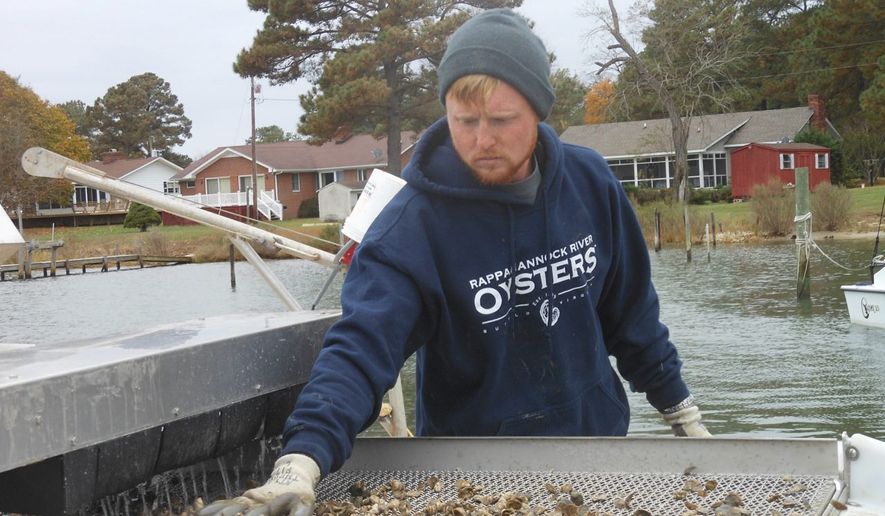IRVINGTON, Va. — If you like oysters — raw, roasted, fried — then hop in the car and drive down to Virginia’s Northern Neck, the peninsula where the Potomac and Rappahannock Rivers join the Chesapeake Bay. The trip from the District takes about three hours; culinary and cultural treats await.
Virginia’s newest tourist attraction is the Virginia Oyster Trail, inaugurated by Gov. Terry McAuliffe on Nov. 9 in the little town of Irvington.
The trail consists of 250 miles of restaurants, raw bars, oyster fields and wineries. It runs along both sides of the Chesapeake Bay and encompasses Virginia’s seven oyster regions, which together produce the largest quantity of fresh wild and farm-raised oysters in the United States.
Oysters have been a Virginia specialty since 1607, when the first Jamestown settlers first harvested them.
With fewer than 500 residents, Irvington is located on the shore of Carter’s Creek, a tributary of the Rappahannock. It served as a steamboat town during the 1890s and early 1900s. The Steamboat Museum on the town common offers visitors a glimpse of what the era was like.
Despite its size, Irvington has much to offer visitors. Just outside the town stands the giant corkscrew statue of the Dog and Oyster Winery, a family-owned business that produces some award-winning wines. It’s named for the rescue dogs that protect the vines from deer that feast on grapes.
Not far from the vineyard sits the beautifully restored mid-18th century Historic Christ Church. Its brickwork, distinctive roof, compass-head windows, high-backed wooden box pews and rare triple-decker pulpit make the building unique. The church holds services every Sunday during the summer and is available to churchgoers of all denominations for weddings and funerals. A small museum explains the church’s history and construction.
A large farmers’ market is held every first Saturday from April to November on the town common. Nate’s Trick Dog Cafe is an excellent place to dine, with its “Oysters Shanghai” providing a spicy delight along with more traditional raw, roasted or fried bivalves, fresh fish and meat dishes.
Irvington is home to the Tides Inn, a resort and spa catering to golfers, fishermen and families, as well as anyone exploring the Oyster Trail.
The Hope and Glory Inn is an elegant bed and breakfast, an 1890s former schoolhouse with two entrances — one for girls, another for boys. Never fear, there’s no separation today. The Inn offers a fine restaurant, cozy bar, well-appointed rooms and cottages in a flower-filled garden. Hosts Dudley and Peggy Patteson (who also own the Dog and Oyster Winery) make their guests happy.
A few miles south of Irvington in Topping, the Rappahannock River Oyster Co. offers visitors a tour of its industry with explanations by the watermen. The company owns the Merroir, a small restaurant on the dock where oysters are brought in from their beds and then treated, first as larvae, and later washed and sorted as mature oysters. The Merroir prepares some of the best food in the area, and there’s nothing like the taste of an oyster fresh from the water.
Reedville, named for sea captain Elijah Reed, who came from Maine to start the menhaden fishing industry, lies on the western shore of the Chesapeake. Menhaden are small, oily fish used for the production of oil, meal and fertilizer. Reedville claims to have once been the wealthiest town in the United States, thanks to the menhaden industry. The grand houses built by fishing boat captains and factory owners became known as Millionaire’s Row. The great wealth has gone, although the menhaden fishing industry remains, as do the beautiful Victorian houses along Main Street.
The region has dozens of vineyards producing dry white wines, the perfect accompaniment to oysters. Of the dozen whites I tasted, my favorite was the Chatham Vineyards 2014 Church Creek. It was dry and full-bodied, reminiscent of a French white Burgundy.
For more information on the region, contact the Virginia Tourism Corp. at Virginia.org or NorthernNeck.org.




Please read our comment policy before commenting.